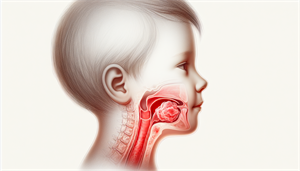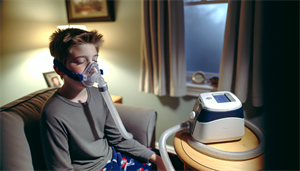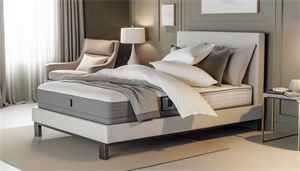It’s late at night, and your child is asleep. But something isn’t quite right. The constant snoring, the gasping for breath, the restless tossing and turning - these are not typical signs of a peaceful night’s rest.
These are signs of childhood sleep apnea, a serious sleep disorder that affects a growing number of children worldwide.
Key Takeaways
-
Pediatric sleep apnea is characterized by repeated breathing interruptions during sleep, with signs such as loud snoring, choking, and daytime sleepiness that can lead to misdiagnosis if not accurately identified.
-
The diagnosis of pediatric sleep apnea relies heavily on polysomnograms and the expertise of sleep specialists who can assess the severity and proper treatment through sleep studies.
-
Treatment for pediatric sleep apnea ranges from non-surgical options like CPAP machines and medication to surgical procedures like adenotonsillectomy, with the approach tailored to the severity and underlying causes of the condition.
Recognizing the Signs of Pediatric Sleep Apnea

Pediatric sleep apnea, a type of obstructive sleep apnea, is an obstructive sleep-related breathing disorder characterized by interruptions in a child’s breathing while sleeping. This condition can disrupt a child’s breathing due to an obstruction in the airway or a lack of coordination between the brain and the breathing muscles.
The initial step towards having obstructive sleep apnea diagnosed in children, also known as pediatric sleep apnea, is to identify its signs. This includes careful observation of your child’s sleep patterns and daytime behaviors for any potential symptoms.
Nighttime Indicators
Nighttime is when the signs of pediatric sleep apnea become most apparent. It begins with loud snoring, which, while common in adults, is not typical in children and could indicate the presence of sleep apnea or enlarged tonsils and adenoids. But snoring alone is not a definitive indication of sleep apnea. Choking, gasping for air, and pauses in breathing are more indicative of serious problems.
These pauses in breathing can occur as frequently as 20 to 30 or more events per hour of sleep. It’s not the occasional snort or snuffle that you need to be worried about - it’s the persistent, disruptive breathing patterns that signal a potential sleep-related breathing disorder.
Daytime Clues
While the nighttime indicators of pediatric sleep apnea are evident, the daytime clues are just as important. A child with sleep apnea may appear excessively sleepy during the day, struggle to concentrate, and perform poorly in school. These signs may be easily mistaken for other medical or behavioral problems, leading to misdiagnosis.
Daytime irritability, in particular, can manifest as:
-
difficulties in concentration
-
hyperactivity
-
aggression
-
mood swings
These behavioral challenges are frequently attributed to the disrupted and non-restorative sleep associated with sleep apnea, often leading to restless sleep. Identifying these daytime indications is vital for diagnosing sleep apnea and starting an appropriate treatment regimen.
Decoding the Diagnosis Process

When it comes to diagnosing pediatric sleep apnea, sleep studies and consultations with sleep specialists are key. An overnight sleep study, or polysomnogram, is the most accurate method for diagnosing sleep apnea in children. It monitors their brain waves, heartbeat, and breathing activity during sleep.
Seeking the advice of sleep specialists guarantees precise diagnosis and an efficient treatment approach.
The Role of Sleep Studies
Sleep studies are instrumental in diagnosing sleep apnea in children. These diagnostic tests, including polysomnography (PSG), pediatric sleep study, and electroencephalogram (EEG), monitor the child’s brain waves, eye movements, heart rate, breathing patterns, and oxygen levels during sleep.
The findings of a sleep study are then analyzed by medical professionals who examine:
-
The Apnea-Hypopnea Index (AHI) to assess the severity of the condition
-
Other factors like sleep disruption
-
The most up-to-date international classification for diagnosis.
Consulting with Sleep Specialists
The diagnosis and treatment of sleep apnea in children heavily rely on sleep specialists. Their comprehensive evaluation of the patient’s sleep history and symptoms, physical examinations, and ordering of diagnostic tests like sleep studies make them indispensable in the treatment process.
When consulting with a sleep specialist, parents should be prepared to inquire about the following:
-
Their approach to diagnosing and treating sleep issues in children
-
Their qualifications and experience in pediatric sleep medicine
-
The diagnostic testing that will be conducted to assess the child’s sleep
-
The development of a personalized treatment plan for the child
-
The accreditation of the sleep lab for children, which ensures the availability of technicians with the necessary child-specific expertise and a precise diagnosis.
Unpacking the Causes of Sleep Apnea in Children

Sleep apnea in children can be caused by a variety of factors. The most common cause is enlarged tonsils and adenoids, which can obstruct the upper airway during sleep. However, sleep apnea can also be linked to neuromuscular problems, such as low airway tone in conditions like cerebral palsy, autism or Down Syndrome.
Besides physical and neuromuscular issues, there’s also central sleep apnea (CSA), a condition where the child’s brain fails to properly signal the body to breathe during sleep, resulting in disrupted respiratory patterns. Understanding these causes and the risk factors associated with sudden infant death syndrome can help parents identify potential issues and seek medical help promptly.
Treatment Tactics for Childhood Sleep Apnea

A variety of options exist for treating pediatric sleep apnea, from non-surgical methods like medication and CPAP machines, to surgical procedures such as tonsillectomy and adenoidectomy.
The selection of treatment hinges on the child’s condition severity and the root cause of the severe sleep apnea.
Non-Surgical Solutions
Non-surgical solutions for pediatric sleep apnea include medications such as nasal corticosteroids and oral montelukast. These medications help reduce inflammation and open up the airways, making it easier for the child to breathe during sleep.
In addition to medication, continuous positive airway pressure (CPAP) machines can be used to treat sleep apnea. These machines deliver continuous air pressure to keep the airway open during sleep, especially useful for children with neuromuscular or craniofacial disorders.
Lifestyle changes, such as establishing a consistent bedtime routine and maintaining a healthy weight, can also help manage symptoms.
Surgical Interventions
For more severe cases of pediatric sleep apnea or when non-surgical solutions are ineffective, surgical interventions may be necessary. The most common surgical procedure is the removal of the tonsils and adenoids, known as adenotonsillectomy.
In addition to adenotonsillectomy, there are other surgical interventions available, such as:
-
uvulopalatopharyngoplasty (UPPP)
-
revision adenoidectomy
-
turbinoplasty
-
septoplasty
-
palatoplasty
-
tongue base reduction
The choice of surgical treatment depends on the child’s specific condition and the underlying cause of the sleep apnea.
Preventing Complications and Promoting Healthy Sleep

Managing pediatric sleep apnea involves not only having obstructive sleep apnea treated but also preventing complications and promoting healthy sleep habits. Regular check-ups with healthcare professionals can help monitor progress and adjust treatment plans as necessary.
Encouraging good sleep habits holds equal significance. This includes:
-
Setting a consistent bedtime routine
-
Creating a comfortable sleeping environment
-
Reducing light exposure before sleep
-
Fostering regular physical activity
By adopting these practices, parents can help their child manage their sleep apnea and improve their overall sleep quality.
Navigating Life with Sleep Apnea
Living with pediatric sleep apnea can be challenging, but with the right support and management, it is entirely manageable. The role of family and friends is pivotal in offering support, motivation, and oversight for the long-term self-management of the condition. They can assist in monitoring symptoms, ensuring adherence to treatment plans, and promoting healthy lifestyle habits.
Communication with healthcare providers is also essential. Regular consultations, detailed record-keeping of sleep patterns, and asking questions for clarification can help manage the condition effectively. Adapting to treatment plans and making necessary modifications in the child’s schedule can make a world of difference in managing sleep apnea.
Summary
In conclusion, recognizing, diagnosing, and treating pediatric sleep apnea is crucial to ensure a child’s overall health and well-being. From observing nighttime and daytime symptoms to consulting with sleep specialists and considering various treatment options, each step in the process is vital. The journey of managing sleep apnea is not an easy one, but with the right information and support, it is entirely feasible. Together, we can help our children sleep better and live healthier lives.
Frequently Asked Questions
Should I be worried if my child has sleep apnea?
Yes, you should be worried if your child has sleep apnea because it can lead to poor quality sleep, making them tired and cranky during the day and potentially causing other health problems, including poor growth.
Does childhood sleep apnea go away?
Yes, childhood sleep apnea can go away with treatment such as surgery to remove enlarged tonsils or adenoids, or wearing a specialized medical device while sleeping.
How do they treat sleep apnea in babies?
Pediatric obstructive sleep apnea can be treated with surgery to remove enlarged tonsils or adenoids, while in other cases, a specialized medical device can be used during sleep. Positive airway pressure therapy may also be considered if other treatments are not effective.
What are the signs of pediatric sleep apnea?
The signs of pediatric sleep apnea can be observed during both sleep and daytime, including loud snoring, gasping for air, pauses in breathing, irritability, excessive sleepiness, difficulty concentrating, and poor school performance. It is important to consult a healthcare professional if these signs are noticed in a child.
What causes sleep apnea in children?
Sleep apnea in children can be caused by enlarged tonsils and adenoids, neuromuscular problems, and issues with the brain's respiratory center. These factors can contribute to interrupted breathing during sleep, leading to sleep apnea.


